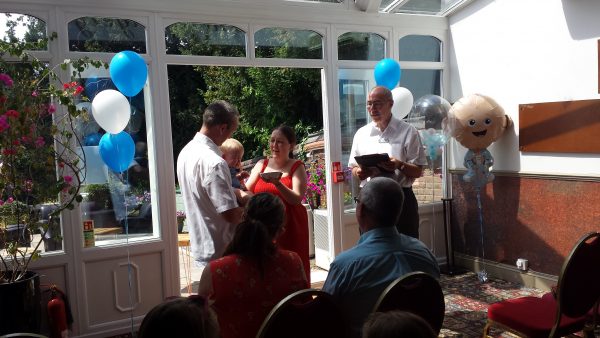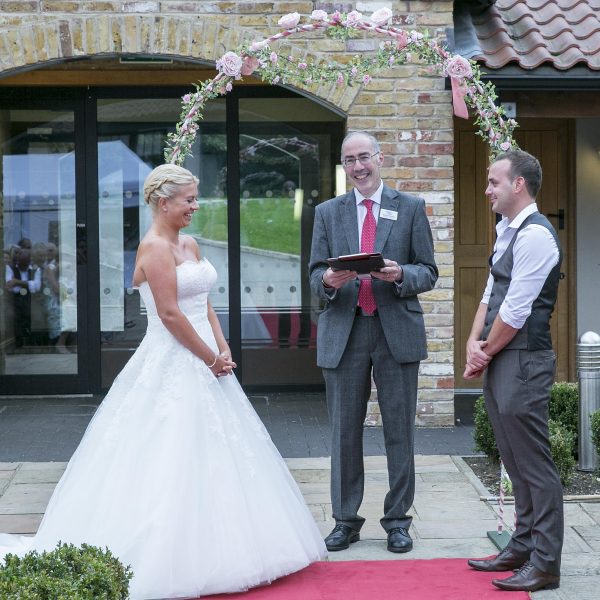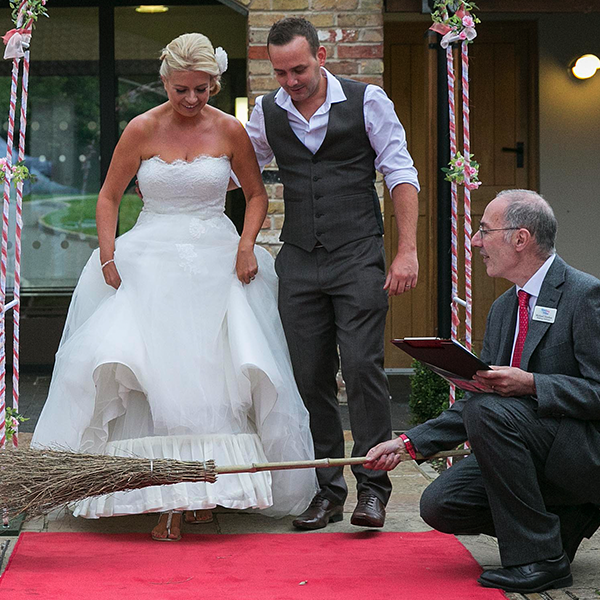
by Michael | Aug 12, 2019 | Blog
It’s normally a joyous moment when a child is born. The birth has huge significance. Not only for the baby but also for the family. New life has entered the world. Hopefully, the new arrival is healthy. It’s surely worth celebrating.
Officially, you have to register the birth; this may be done at the hospital or at the Register Office within 42 days. That’s the formal bit. It’s just signing a bit of paper. Not very exciting.
So what about celebrating?
What not to do!
In many cases, a major celebration straight after the birth is not appropriate. The mother (and, of course, the baby) might be unwell; sleep might easily be a major issue, and the parents are undergoing full-time lessons on how to look after their child. The last thing anybody needs is the stress of organising a shindig (although a drink with a few close friends or relatives might be desirable).
What to do, if you’re religious
For practising
Jews, for example, there may be circumcision for a boy, which normally takes
place about 8 days after birth. That can be an excuse for some sort of party.
Devout Christians
will arrange a baptism or similar ceremony with their local church. They may
follow that with a party.
What you might do, if you’re not
If you’re not into religion big-time, you may look for another option. Did you know that a civil celebrant can compile and conduct a bespoke naming (or blessing) ceremony? This needn’t be over-long. It can include some religious readings – or else, purely spiritual – and can involve parents and also people of your choosing. The readings can be chosen by you, if you want. There might be something ceremonial too, like rose petal strewing, which can make the event stand out even more.
There are ways (such as using a Unity Candle) that the family at large can be involved, so no one needs to feel left out.
You can hold the ceremony in your house, in the garden, in a hotel, or wherever you choose. You can also hold it whenever you want – there is no prescriptive time-frame.
There really is a lot of choice, and that’s the point. You don’t have to put up with either full religious or else nothing at all; the celebrant-led ceremony is a really viable alternative.
Ask your local celebrant for more information!

by Michael | Jun 6, 2017 | Blog
You may have seen photos on my website of one particular wedding where I officiated. They bring back lovely memories for me (and, hopefully, for the couple concerned!). I thought I’d share the story of their wedding with you.
Lucy and Dave had already married on Skiathos in front of a few close friends and relatives. They wanted to share their happiness with their wider circle. So a wedding blessing was fixed for a Friday in August – an outside ceremony near a converted barn in the Enfield/Cheshunt area just north of London.
It had been quite a hot day, and the 5 p.m. start avoided the worst of the heat. Unfortunately, although almost everybody was ready then, that wasn’t the time the ceremony actually started. News filtered through that the best man was stuck in traffic on the M25 motorway. And before anybody asks why he hadn’t left home sooner, the fact was that he had actually been at a job interview (successful!), and had been unable to get away sooner!
So a few drinks were consumed and we all settled down to wait. While Lucy stayed secreted with her entourage, Dave was clearly a bit nervous, and this delay didn’t help him.
Another consequence of the delay was that the weather started to turn very noticeably.
However, an hour or so later than scheduled, with the best man refreshed and ready, Dave and I were positioned under a lovely floral arch. Lucy made her entrance up the red carpet leading to us. What a picture! She was radiant, resplendent, confident that all eyes were fixed admiringly upon her and her approach was stately.
The service of blessing began. After my welcome, and mention of absent friends, I talked briefly about Lucy and Dave’s story that nearly never happened (as Dave had chickened out of popping the question when the time seemed right). Anyway, the next time the opportunity arose, in Warwick Castle, he pretended to offer Lucy a chocolate bar; when she unwrapped it, she found a ring.
The ceremony continued, but about this time, a wasp decided to get involved, and it buzzed around the three of us very persistently. This didn’t help Dave’s nerves, or, if I’m honest, mine. Lucy was seemingly imperturbable, though.
This being Britain, “the show had to go on”, and as we proceeded to readings about love and then words of wisdom about marriage. This seemed to interest the wasp rather less. Unfortunately, there was a practical reason for this, which was that the heavens decided that this would be a good time to open!
As the celebrant, I felt that, although we still had a few minutes left ahead of us, we could hardly stop the ceremony. So we moved on to the significance of the rings. As we three were getting decidedly damp (most of the guests had fled for some nearby shelter), an enterprising bright spark picked up a table parasol, opened it and brought it up to the front so that Lucy (though not we men-folk) could be protected. This caused a good deal of merriment, and helped Dave to relax.
As the shower passed, I recited the lovely Apache (Navajo) wedding blessing, with its rather ironic (in the event) beginning:
“Now you will feel no rain, for each of you will be a shelter for the other. Now you will feel no cold, for each of you will be warmth to the other. Now there will be no loneliness, for each of you will be a companion to the other. Now you are two persons, but there is only one life before you. Go now to your dwelling place to enter the days of your togetherness. May beauty surround you both in the journey ahead and through all the years. May happiness be your companion, and may your days together be good and long upon the earth.”
Lucy and Dave had been adamant when we were planning the ceremony that there should be some light-hearted elements. So before we ended, there was the pagan “Jumping the Broom” ceremony. I explained that Lucy and Dave would together jump over the broom to symbolise a new beginning, a welcoming of the new – sweeping away old cares and worries. “This represents entering into a new life of husband and wife. The wood represents the strength of the commitment in the marriage. The leap symbolises joyfully taking the leap into married life together.“

I then held the broom some two feet above the ground and invited Lucy to hurdle it in her dress. To the onlookers’ delight, she looked aghast, as was the intention. Of course, I then lowered it to a few inches above the ground!
It was a lovely, warm occasion for a delightful couple; everybody had a smile on their face, and there’s an even happier end to the story: twins for the pair a year or so later!
Wonderful memories, indeed!
by Michael | Aug 19, 2015 | Blog
Most people are familiar with the line that we have two ears but only one mouth because we ought to be listening twice as much as we speak.
Well, you might wonder how that applies in my job, as the popular image of a civil celebrant is that person standing up at the front, conducting the ceremony – be it a wedding, funeral, handfasting, blessing, naming or whatever – and jabbering away. In other words, I do the speaking and you (have to) do the listening!
However, there is another part of the proceedings that you probably wouldn’t think about, and that is when the ears/mouth equation comes into its own for me. That is during my planning meeting with the client.
After the initial contact, I almost always visit the next-of-kin, if it’s a funeral, or, if it’s a celebration, arrange a face-to-face or Skype meeting with the couple. As well as being an opportunity to see if we’re both OK to work together, this is a chance for the client to ask questions in an unintimidating atmosphere. For me, it is also an opportunity to ask questions and also to suggest ideas. (Yes, that does involve more talking!)
However, in reality, most of this conversation for me will be spent listening (although there is the occasional case – usually caused by shock after a death – when the client will say next to nothing, and I have to work at gaining their trust). I need to pay close attention, as I often have to pick up clues about what the client wants, as they may not really have much of a conscious idea themselves.
If the client does know exactly what they are looking for, my role is to take note so I can mould it in the best possible, most effective, way. I may question an element or two (“do you realise that …?”), but it’s not my job to change anything (provided everything’s legal, etc.).
I respect their wishes – they can have a mixture of religious elements (or none, if they choose) – and I try to accommodate any preferences they may have for readings, music and participants.
If they don’t know what they want, then I ask questions to get a sense for the sort of thing they may like and provide suggestions for possible rituals to fit the bill. When I finish, I try and put this all together to construct a meaningful and memorable ceremony that meets the needs – and beliefs – of the client. So maybe I do still sometimes talk a bit more than I listen, but I hope I’m getting the balance right.
Another way I’d love to put “two ears, one mouth” into practice is to respond to any requests you may have for subjects for me to deal with in my blogs. To quote my hero, Frasier Crane, “I’m listening!”



